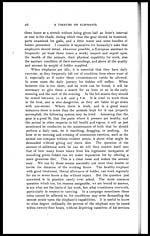Medicine - Veterinary > Veterinary diseases > Elephants and their diseases > Part I - Supply, general hygiene, gear, mounting and restraint
(57) Page 27
Download files
Individual page:
Thumbnail gallery: Grid view | List view

WORK AND EXERCISE. 27
for the next twenty-four hours or longer period. The reply is com-
plicated, and can hardly be given in the form of any definite amount;
so many are the elements of each problem, so variable may these
separate elements be upon one and the same occasion, as to make
the laying down of rigid rules inadvisable. There are to be considered
(1) the load ; (2) the configuration of the ground over which the road
lies ; (3) the nature of its surface; (4) the time of day; (5) the
existence or absence of shade ; (6) the number of days' rest enjoyed
immediately before, and in prospect immediately after, the march ;
(7) the quality and quantity of fodder and water available. From
which collectively may be deduced the number of miles the animal
can safely traverse. It must never be lost sight of that the elephant
is a nocturnal animal ; therefore all work should as much as possible-
be done in the early morning and evening. It must also be borne
in mind that in continuous exertion like marching, fatigue comes on
almost imperceptibly ; we are then more likely to be deceived in
measuring the staying power of the elephant than in work of a
spasmodic and intermittent kind, such as dragging or pushing timber
on the ground. If a log be too heavy, the animal will snort, refuse,
or move it but a short way at a time ; but in carrying a load that at
the first start off sits easily, the animal becomes exhausted almost
unconsciously to himself. After a pause on the march he is unable
to overcome the stiffness that immediately supervenes, and if he be
goaded too much may drop down suddenly to rise no more. A
good attendant will generally give timely notice of the possibility of
such an occurrence.
The elephant is by conformation a beast of burden, and though
he goes in draught he is out of place in it, as it throws him into an
unnatural position, and he loses much of the advantage his size,
weight and strength give him. Elephants are employed for
draught in the heavy siege batteries. Opinions vary as to the
absolute weight an animal can carry. Of course the greatest weight
he can sustain can be moved over short distances only, and medium
loads over less space than light ones. Under some circumstances it
is as much as an elephant can do to move the weight of his own
body, not to speak of a heavy load, or a log of timber.
The Government loads vary from 1,000 to 1,200 lbs., but
1,000 lbs. including everything is a good load, and if elephants are
to be worked for any time, it is inadvisable to make them carry
even so much.
As regards dragging in the hills, if about three hours in the
morning and three in the evening. and not more, be devoted to work,
it will doubtless occur that the number of logs worked out in a season
will fall below the average. Figures quoted with reference to this
Set display mode to: Large image | Zoom image | Transcription
Images and transcriptions on this page, including medium image downloads, may be used under the Creative Commons Attribution 4.0 International Licence unless otherwise stated. ![]()
| India Papers > Medicine - Veterinary > Veterinary diseases > Elephants and their diseases > Supply, general hygiene, gear, mounting and restraint > (57) Page 27 |
|---|
| Permanent URL | https://digital.nls.uk/75192191 |
|---|




